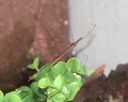Ranatra
Ranatra
Classification
- Phylum: Arthropoda
- Subphylum: Hexapoda
- Class: Insecta
- Order: Hemiptera
- Suborder: Heteroptera
- Infraorder: Nepomorpha
- Superfamily: Nepoidea
- Family: Nepidae
- Genus: Ranatra
Pronunciation
How to pronounce Ranatra: /ræˈneɪtrə/
These audio files are automatically generated. While they are not always 100% accurate, they are a good starting point.
Images





Summary
Ranatra is a genus of predatory insects in the family Nepidae, commonly known as water scorpions or water stick-insects. They are characterized by their long and slender bodies and are found in a variety of aquatic habitats worldwide. They use their strong front legs to catch prey and have a specialized siphon for breathing.
Physical Characteristics
Long and slender body, typically 2–6 cm in length, with a long tail-like siphon for breathing. Brown coloration is common. Wings are present, allowing for flight.
Identification Tips
Look for their elongated body, strong front legs that are used for grasping prey, and the distinctive siphon at the rear, which is used for respiration.
Habitat
Freshwater habitats including stagnant or slow-moving water such as ponds, marshes, and canals; they are occasionally found in streams and hypersaline lakes.
Distribution
Primarily found in North America, South America, Asia, Australia, and parts of the Palearctic, with some species widespread in eastern U.S. and Canada. R. fusca is transcontinental in Canada and most of the U.S.
Diet
Predominantly feeds on other insects, tadpoles, and small fish, utilizing a proboscis to inject saliva for predation.
Life Cycle
Eggs are laid on plants just below the water surface, or in mud, taking about two to four weeks to hatch; young take approximately two months to mature.
Reproduction
Often lays eggs on submerged vegetation; reproductive activity can occur year-round except during extreme cold.
Ecosystem Role
Predatory insects that help control populations of other aquatic organisms, serving as both predators and prey in the aquatic ecosystem.
Collecting Methods
- Netting from aquatic environments
- Visual spotting and hand collection
Preservation Methods
- Alcohol preservation
- Pinning for museum specimens
Similar Taxa
- Nepidae
- Cercotmetus
- Austronepa
- Goondnomdanepa
Misconceptions
Often referred to as scorpions due to their appearance, they are not related to scorpions but are insects classified under true bugs.
Tags
- insects
- aquatic
- predators
- Hemiptera
- Nepidae